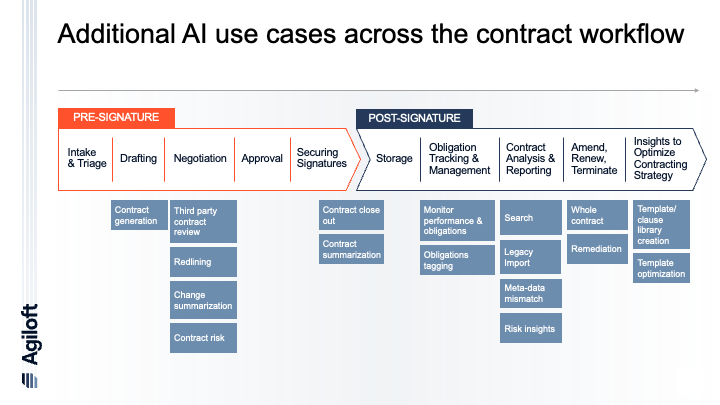
Clippy, Siri, Alexa, and the evolution of the AI assistant
From Clippy, to Siri, to Alexa, we've grown used to the virtual assistant. How can this AI experience translate to your contracting life?

On March 13th, Agiloft Chief Product Officer Andy Wishart spoke with the Lexology audience on the AI landscape, where it started, how it’s been going, and what we can expect to see from it in the future. In the nearly one-hour presentation, Andy held a frank discussion on not only the practicality of AI, but the overall feelings and thoughts on AI use across the legal and contracting space.
First, after reviewing his extensive background (where he mentioned that he’s been studying artificial intelligence since the 90’s, before most of us considered it anything other than some computer/human hybrid a la Arnold Schwarzenegger) he talked through Agiloft as a whole, breaking down each element where the technology plays a role, both pre and post signature. Today, we’ll go through each of those steps, and explore the AI tools that Agiloft has put into place to assist along the way.
Before getting into specifics, let’s highlight a few other important overarching points that were made throughout Andy’s presentation:
1. AI has been around a lot longer than you realize.
“I think the first point I would make is that AI has been around for a long long time…machine learning dates back to the 1950s, but really began to flourish in the mid to late 90s,” Andy said.
2. A human is required to successfully operate this machinery.
While cheekily comparing AI to a being that “must be accompanied by someone 18+” to enter, it’s a great analogy to describe the infancy we’re in when you’re looking at AI tools. We’ve gotten used to things being easy or instantaneous in our everyday lives, yet people are still hesitant to put full trust into the “machine,” and rightfully so. Andy mentioned, “Tools like ChatGPT have changed the way in which people think about how an intelligent assistant should work, but you know it can get things wrong. Humans still need to feel in control, humans need to be in the loop.”
3. You’re probably already using it.
“Some [teams] actually might not be aware that they’re using AI within the tools that they’re currently utilizing. Sometimes the best AI is completely hidden, part of their everyday workflow, whether that’s searching or analyzing content.”
So what does this mean for contracting?
Let’s work through the contracting workflow and see how AI, as an assistant and not a replacement, can transform your contracting process.
“AI as things stand today, is a means to assist professionals in bringing efficiencies into their work.”

Pre-signature
Andy highlighted early on the different stages within a contract lifecycle, and where he believes that AI could intervene.
As it stands today, Agiloft’s AI platform and ConvoAI functionality already act as smart assistants throughout the contracting workflow, beginning with the third-party contract review and redlining stage.
Agiloft’s AI tools analyze your inbound documents, assessing risk and identifying language that deviates from what you’ve laid out in playbooks and across your clause library. You’re now automatically assessing risk, introducing a new fail-safe for compliance, and significantly increasing the speed at which you’re able to review and analyze a document.
After initial contract analysis, you move directly into the negotiation process where you can leverage generative AI, to take those highlighted and somewhat questionable proposals to create a mutually beneficial redline.
Post Signature
Once the agreement has been signed, the opportunities to leverage AI don’t go away. As Andy mentions throughout the presentation, smart search of both your entire repository and individual documents themselves is imperative in ongoing contract management. Importing and organizing historical documents and the valuable data that’s held within them is also important when it comes to increasing the value of your overall CLM instance. Finally, generative AI can assist with future planning and compliance when you utilize tools to help create, hone, and optimize your clause, template, or playbook libraries.
What are our takeaways?
Ultimately, I think it’s a quick look back at AI to really decide how to best understand how to utilize it moving forward. When Microsoft Word introduced Clippy, the paper clip assistant in 1996, there was hesitation, excitement, annoyance, intrigue—it’s even garnered the name of “The World’s Most Hated Virtual Assistant.” Around 2010, the world was introduced to Siri – an assistant in your pocket – and some were even more excited while others were even more hesitant. That sentiment continued to grow when we met Alexa in 2014, an assistant right in your own home. What’s the key word in these examples? Assistant.
If we take away nothing more from Andy’s presentation with Lexology, it’s that one key phrase, “human in the loop.” Right now, AI is meant to make your life easier, become a valuable assistant that protects you against risk and helps you to work faster, delegating your time to more important tasks or simply giving it back to you to enjoy. The concept of leveraging these AI models to make your life easier is becoming table stakes across the industry, do you want to be left behind?
Recent
Posts
Learn about the realities of AI today, its limitations and capabilities, and its use as a “force multiplier” for contracting.
If there is one message for tech buyers as we approach 2024, it is that AI is here – ready or not.
With the introduction of ConvoAI, Agiloft delivers the same benefits of simplified AI experiences to the world of contracts.






